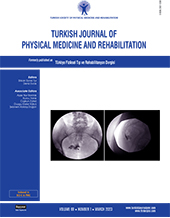Effects of a combined progressive resistance training and functional electrical stimulation-evoked cycling exercise on lower limb muscle strength of individuals with incomplete spinal cord injury: A randomized controlled study
2 Discipline of Rehabilitation Medicine, Faculty of Medicine, University of Malaya, Kuala Lumpur, Malaysia
3 Department of Biomedical Engineering, Faculty of Engineering, University of Malaya, Kuala Lumpur, Malaysia
4 Sydney School of Health Sciences, Faculty of Medicine and Health, University of Sydney, Sydney, NSW, Australia
5 Clinical and Rehabilitation Exercise Research Group, Faculty of Health Sciences, Universiti Teknologi MARA, Puncak Alam Campus, Selangor, Malaysia
6 Integrative Pharmacogenomics Institute, Universiti Teknologi MARA, Puncak Alam Campus, Selangor, Malaysia DOI : 10.5606/tftrd.2023.9418 Objectives: This study was conducted to investigate the effects of combined progressive resistance training (PRT) and functional electrical stimulation-evoked leg cycling exercise (FES-LCE) on isometric peak torque and muscle volume in individuals with incomplete spinal cord injury.
Patients and methods: In the single-blind, randomized controlled trial performed between April 2015 and August 2016, 28 participants were randomized between two exercise interventions (FES-LCE+PRT and FES-LCE alone), and training was conducted over 12 weeks. The isometric muscle peak torque and muscle volume for both lower limbs were measured at the baseline and after 6 and 12 weeks. Linear mixed-model analysis of variance was performed to test the effects of FES-LCE+PRT versus FES-LCE on each outcome measure over time via an intention-to-treat analysis.
Results: Twenty-three participants (18 males, 5 females; mean age: 33.4±9.7 years; range 21 to 50 years) completed study (10 in the FES-LCE+PRT group, and 13 in the FES-LCE group). The 12-week pre-and posttraining change for left hamstrings` muscle peak torque in the FES-LCE+PRT group (mean difference=4.5±7.9 Nm, 45% change, p<0.05) was consistently higher than that in the FES-LCE group (mean difference=2.4±10.3 Nm, 4% change; p<0.018). The improvement in the right quadriceps muscle`s peak torque of the FES-LCE+PRT group (mean difference=19±7.6 Nm, 31% change, p<0.05) was more significant compared to the FES-LCE group. The left muscle volume showed a remarkable increase after 12 weeks in the FES-LCE+PRT group (mean difference=0.3±9.3 L, 7% change, p<0.05).
Conclusion: The combination of PRT and FES-LCE was better in improving lower limb muscle strength and volume in chronic incomplete individuals with spinal cord injury.
Keywords : Electrical stimulation, ergometry, muscle strength, resistance training, spinal cord injuries

















